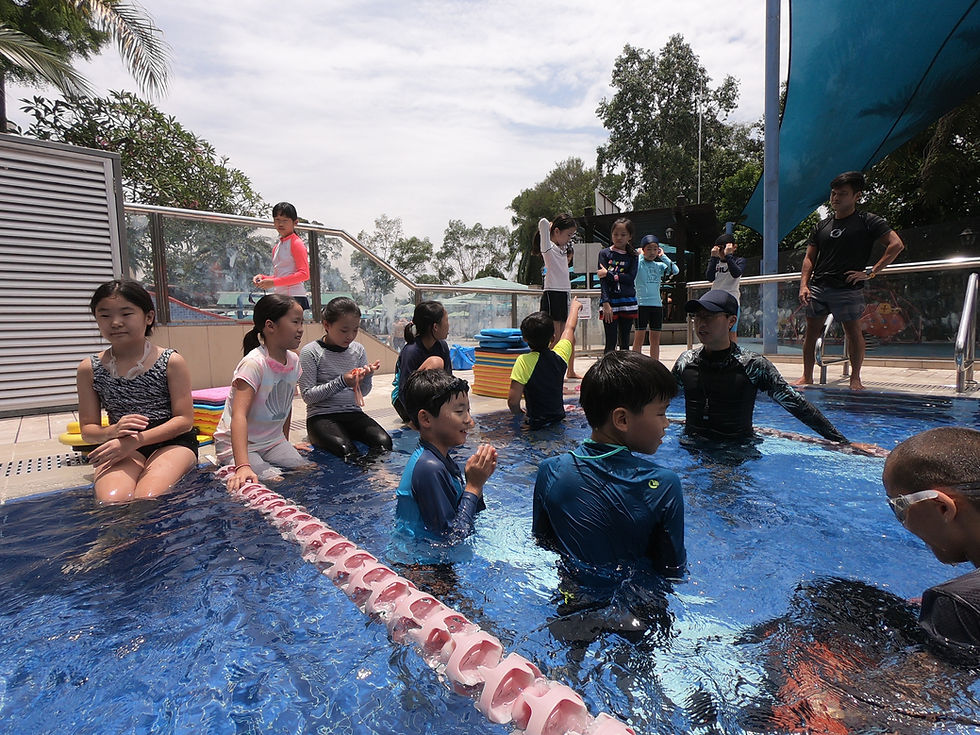Using Gentle Techniques to Build Water Comfort
- SG Sink Or Swim

- 1 day ago
- 4 min read

Creating Safety, Trust, and Joy — One Gentle Step at a Time
For many children — and even adults — the water can feel like a foreign, intimidating world. The sounds, the sensations, the loss of solid ground — it’s no wonder that hesitation, anxiety, or outright fear can take hold. But force, pressure, or “sink-or-swim” methods only deepen that fear, sometimes for a lifetime.
The path to water comfort isn’t through pushing — it’s through gentleness. It’s about creating a safe, predictable, and joyful environment where trust can grow, confidence can blossom, and the water becomes a place of play, not panic.
In this guide, we’ll explore compassionate, evidence-based techniques to build water comfort gently — whether you’re a parent, instructor, therapist, or caregiver.
🌊 Why Gentleness Works
Fear shuts down learning. Safety opens it up. When a person feels secure, their body relaxes, their mind stays present, and new skills take root naturally.
Gentle techniques honor the nervous system’s need for control, predictability, and consent — especially for children with sensory sensitivities, trauma histories, or developmental differences.
“You can’t rush a flower to bloom. You give it sun, water, and time. The same is true for water comfort.”
🧸 Core Principles of Gentle Water Introduction
1. Follow the Learner’s Lead
Never force submersion, floating, or entry
Let them set the pace: “Would you like to sit on the step, or watch first?”
Celebrate tiny steps: touching water, blowing one bubble, sitting at the edge
2. Create Predictability
Use consistent routines: “First we sit, then we splash, then we blow bubbles”
Give verbal warnings: “In 3 seconds, I’ll pour water on your shoulders”
Use visual schedules (pictures of steps) for children who benefit from structure
3. Prioritize Connection Over Performance
Make eye contact, smile, and use a calm voice
Focus on bonding, not milestones
Say: “I’m right here with you” — not “You can do it!”
4. Offer Choices and Control
“Do you want to use the blue cup or the red cup to pour water?”
“Would you like to hold my hand or the wall?”
Control reduces anxiety — even small choices build confidence
🎮 Gentle, Playful Activities That Build Comfort
1. “Bubble Blowing” on the Steps
Sit together on pool steps, chin in water
Blow steady stream of bubbles — no pressure to submerge
Add fun: “Make big bubbles! Tiny bubbles! Singing bubbles!”
💡 Tip: Use a straw or toy whistle to make it a game.
2. “Magic Potion” Pouring
Give child a small cup
“Let’s make a magic potion! Pour water on your arm… your tummy… your knees!”
They control the flow — no surprises
🌈 Imagination transforms fear into curiosity.
3. “Mirror Faces”
Make silly faces with mouth in water (fish face, bubble lips)
Child copies — no pressure to blow or submerge
Laugh together — joy builds safety
😛 Use a mirror on the pool wall so they can see themselves.
4. “Glow Stick Float” (For Older Beginners)
In calm, dim water, hold a glow stick on chest
Practice back floating with support
The visual focus distracts from fear
✨ Creates a peaceful, magical experience.
5. “Toy Rescue” in Shallow Water
Place floating toys just within reach
“Can you touch the duck with your toes?”
Builds comfort with water on legs and gentle movement
🦆 Purpose reduces anxiety — they’re focused on the mission, not the water.
🧠 Special Considerations
For Children with Autism or Sensory Processing Differences:
Use tinted goggles to reduce visual glare
Offer nose clips if water in nose is distressing
Start with dry land water play (spray bottles, water tables)
Respect sensory limits — no forced splashing
For Those with Water Trauma:
Go even slower — weeks or months of just sitting at the edge may be needed
Never surprise them — always narrate what’s coming
Partner with a trauma-informed therapist if possible
For Adults Overcoming Fear:
Acknowledge the courage it takes to try
Avoid child-like language — use respectful, collaborative cues
Focus on breathwork and relaxation first
💬 What to Say (and What Not to Say)
✅ Do Say:
“You’re safe. I’ve got you.”
“Let’s try just one bubble.”
“You can stop anytime.”
“I’m proud of you for trying.”
❌ Don’t Say:
“Don’t be scared!” (invalidates feelings)
“Just jump in!” (removes control)
“You’re fine!” (dismissive)
“Look how easy it is for your sister!” (comparison)
🤝 The Role of the Adult: Be the Safe Harbor
Your energy is contagious. If you’re anxious, they’ll feel it. If you’re calm, they’ll borrow your calm.
Breathe deeply before entering the water
Move slowly — no sudden gestures
Stay present — put your phone away
Celebrate effort, not outcome — “You touched the water — that’s brave!”
Final Thoughts
Building water comfort isn’t about getting someone to swim. It’s about helping them feel safe, seen, and in control in a new environment. It’s slow. It’s patient. It’s full of tiny victories.
But every bubble blown, every drop poured, every moment of trust is a step toward a lifetime of joy in the water.
So go gently.Listen deeply.And let the water meet them — exactly where they are.
Breathe. Blow. Believe.
In the water, courage isn’t loud — it’s a whisper of trust. 💙🌊





Comments